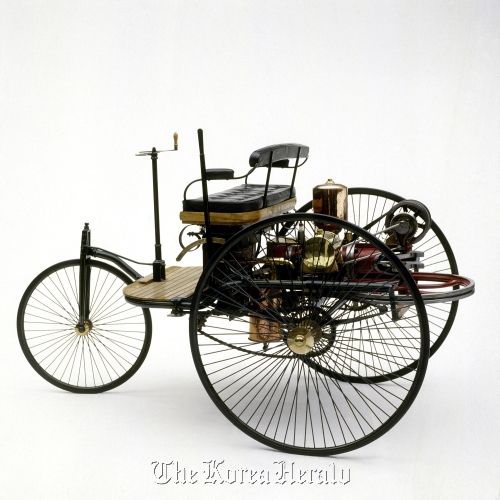The tricycle that roared ― world’s first car weighed-in 125 years ago
By 최희석Published : Jan. 30, 2011 - 17:42
STUTTGART, Germany (DPA) ― It is not the most handsome, the most valuable or the fastest of its kind but it does have a very special distinction.
The frail-looking patent motor vehicle in the style of a tricycle which burst on the scene in Germany 125 years ago is regarded as the world’s very first automobile.
Replicas of the pioneering three-wheeler submitted to the German Imperial Patent Office on January 29, 1886 change hands today for around 65,000 euros ($86,800).
The prototype device with its clattering, water-cooled horizontal single-cylinder gas engine was given the patent specification 37435and submitted by engineer Carl Benz.
He handed in the document with detailed drawings only a few weeks before his later associate Gottlieb Daimler lodged a similar application for a horseless carriage. The word was later shortened to “car.”
Until then the men had no inkling of each other’s ideas for a revolutionary mode of transport which initially had little in common with today’s modern automobiles.
The frail-looking patent motor vehicle in the style of a tricycle which burst on the scene in Germany 125 years ago is regarded as the world’s very first automobile.
Replicas of the pioneering three-wheeler submitted to the German Imperial Patent Office on January 29, 1886 change hands today for around 65,000 euros ($86,800).
The prototype device with its clattering, water-cooled horizontal single-cylinder gas engine was given the patent specification 37435and submitted by engineer Carl Benz.
He handed in the document with detailed drawings only a few weeks before his later associate Gottlieb Daimler lodged a similar application for a horseless carriage. The word was later shortened to “car.”
Until then the men had no inkling of each other’s ideas for a revolutionary mode of transport which initially had little in common with today’s modern automobiles.

The driver took up position on a padded wooden bench and enjoyed no protection whatsoever from the elements. With no covering roof the first car was also the very first powered cabriolet.
The carriage ran on spindly wooden wheels and was driven by an engine weighing 100 kilograms. The motor turned over at a modest 400 revolutions a minute - modern racing engines rev up to more than 20 times that pace.
The engine was set into motion using a flywheel and the 270-kilo car developed less than one horsepower. Top speed was a dizzying 16 kilometers an hour.
Benz carried out the first secret trials of his new-fangled car in Mannheim in 1885. To avoid the prying eyes of potential rivals he only took to the roads after dark.
On its first run the tricycle managed to travel just a few hundred meters but improvement was rapid. In his memoirs the inventor wrote: “Each journey boosts my confidence and on every trip I learn more about the pitfalls of the engine.”
Public reaction to the strange new vehicle was initially one of skepticism. Benz noted that “astonishment and admiration has turned to pity, insult and scorn. The vehicle’s detractors asked why anyone should want to ride in this noisy, primitive and unreliable contraption when there were more than enough horses in the world.”
The pioneer was unperturbed. The first breakthrough came a few years later when his intrepid wife Bertha successfully piloted model number 3 from her parents’ home to the town of Pforzheim in August 1888.
She did not tell her husband about the trip beforehand and the outing has since gone down in the annals of motoring as the very first long-distance automobile excursion.
The Benz boys Eugen and Richard often had to push their under-powered cars uphill but the various family adventures ensured plenty of publicity. Benz was able to sell 25 examples of his patent car.
Although Benz himself only ever built one of his cars, model number 1, replicas of the remarkable vehicle were on sale even before World War II, said Winfried Seidel, who runs the Dr. Carl Benz Museum in Ladenburg. One of the tricycles is on display in the old Benz workshops. Mercedes-Benz commissioned the construction of 11 examples in 1986 to mark the vehicle’s 100th anniversary.
The car has found its way into private hands too after a company in England was given special dispensation by Mercedes to make between 150 and 200 copies. They can be purchased new via Mercedes or secondhand on the internet, at auction or through advertisements for around two-thirds of that sum.
The ability of the tricycle to travel under its own power as an “automobile“ was what set it apart but most purchasers today are not interested in driving the device. “Most are on display in museums or as part of private collections,” said Seidel.
The director does know of one prominent exception: Jutta Benz. “After all, Carl and Bertha Benz were my great-grandparents,” said their heir who still lives in Mannheim. She prefers a more modern example of the marque for everyday transport but for shows and on special occasions she often sits on the wooden bank for a three-wheeled chug around the locality.







![[KH Explains] How should Korea adjust its trade defenses against Chinese EVs?](http://res.heraldm.com/phpwas/restmb_idxmake.php?idx=644&simg=/content/image/2024/04/15/20240415050562_0.jpg&u=20240415144419)










![[Today’s K-pop] Stray Kids to return soon: report](http://res.heraldm.com/phpwas/restmb_idxmake.php?idx=642&simg=/content/image/2024/04/16/20240416050713_0.jpg&u=)